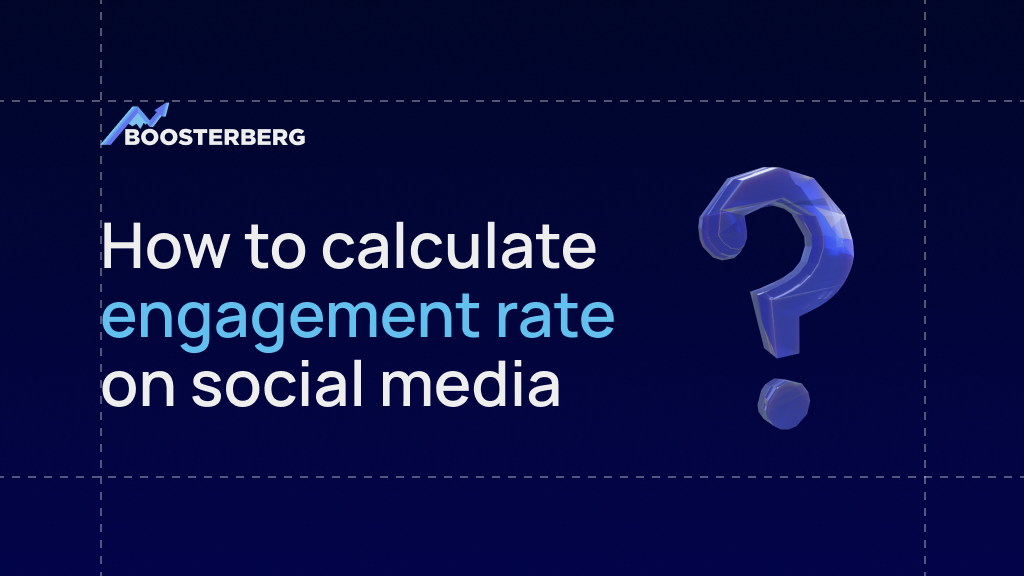Knowing how to calculate your engagement rate is essential, especially in 2022. It’s evident that more people are drawn to that part of virtual existence in a world, where social media plays such a significant role in our daily lives. And we can’t blame them.
Imagine social media as a new realm or another universe where you still have to make a living. Yes, you still have to pay for advertisements and other things, but in a world like this, engagement rates are the currency.
In this article, you will learn what engagement rate is exactly, why it is necessary, and how to calculate it correctly for each social media platform.
1. What is engagement rate
We could say, that the engagement rate is one of the most important metrics in the social media sphere. There is a lot of possible definitions for engagement rate, so take it with a grain of salt, but at Boosterberg, we define it as measurement: “Amount of interaction that social media content receives in relation to audience size, followers, or reach.” While, reactions, likes, comments, shares, saves, direct messages, mentions, clicks, and other activities are examples of interactions (depending on the social network). There are several techniques to calculate engagement rate, and some may be more appropriate for your social media goals than others.
It is possible that you read a lot of definitions on the internet. But in general in the social media world, “engagement” typically refers to behavior that are more active than passive (such as views or impressions). So we could say you can make your definition, as long as you consider engagement as some activity.
2. Why is it important to calculate the engagement rate on social media
In order to determine if your engagement rate is good or bad, it must be calculated so it is possible to benchmark it against something else. You can begin by asking yourself: “what your end goal is?”, then take measurements in accordance with it. These questions can help you to determine the goal:
– How your content performs in a specific time period? (benchmark against your own engagement rate over time)
– Establish a standard for the performance of your industry’s social media engagement (benchmark against top industry players)
– Compare your performance against your rivals (benchmark against your closely matched competitors)
Compare how you did on various social media platforms,, e.g. Facebook vs Instagram. (benchmark against your own social media profiles)
So we could say, calculating your engagement rate will help you determine the calibre of your content, how your brand compares to that of your rivals, and whether or not your paid Ads and sponsored content are yielding positive results.
But besides the benchmark, knowing your cost per engagement (CPE) can help you determine whether you are making good use of your funds. (CPE is calculated as total spending divided by total engagements.)
This and other cost calculations, such as cost-per-click (CPC), are actually done for you by the majority of social media advertising networks, but sometimes it is good to remind that, as it can get quite complex, right?
3. Engagement rate for each platform
Let’s illustrate the formula with an actual example, if company “Social Inc.” posted on Facebook to their 1,000 fans and received:
30 likes
20 comments
10 shares
This means that their total engagement would be 60 (30+20+10). Let’s plug this into the equation:
Social Inc. Engagement Rate will be = 60 / 1,000 = 0.06 x 100% = 6%
In this case, we used Likes, Comments and Shares. But you can apply the same formula with different metrics, like Instagram story views, likes and reactions or Likes, Comments and retweets on Twitter, etc.
What Is the Standard Engagement Rate on Instagram?
Millions of Instagram feed posts (excluding Reels) were examined by Later in this article (https://later.com/blog/instagram-engagement-rate/), and it was discovered that the average engagement rate is 2.88 percent.
The average engagement rates for carousel posts are 3.11 percent, pictures are 2.76 percent, and videos are 2.60 percent, to further split that statistic down.The typical engagement rate for posts, pictures, and videos on carousels in 2021 and 2022 (excluding reels).
You can see from Later’s analysis that carousel posts perform better than image and video posts. Which shouldn’t come as a surprise given how well they encourage involvement.
So, using unique carousel posts is a wonderful option if you want to enhance interaction on Instagram.
Final thought
Ultimately, engagement rate is one of yours best social media metrics to track if you want to see how your content is resonating with your audience.
Don’t miss out on our e-book – a complex guide to social media – for more! And don’t forget to share this post!
Check out our other posts like “How to calculate engagement rate on social media” to get more out of your content, and make sure to free up some time for other importing things with our Ads automation tool – BOOSTERBERG.
Focus on ideas and content, not on manual ad management. Try BOOSTERBERG for a hassle-free way to get ahead in marketing automation!
